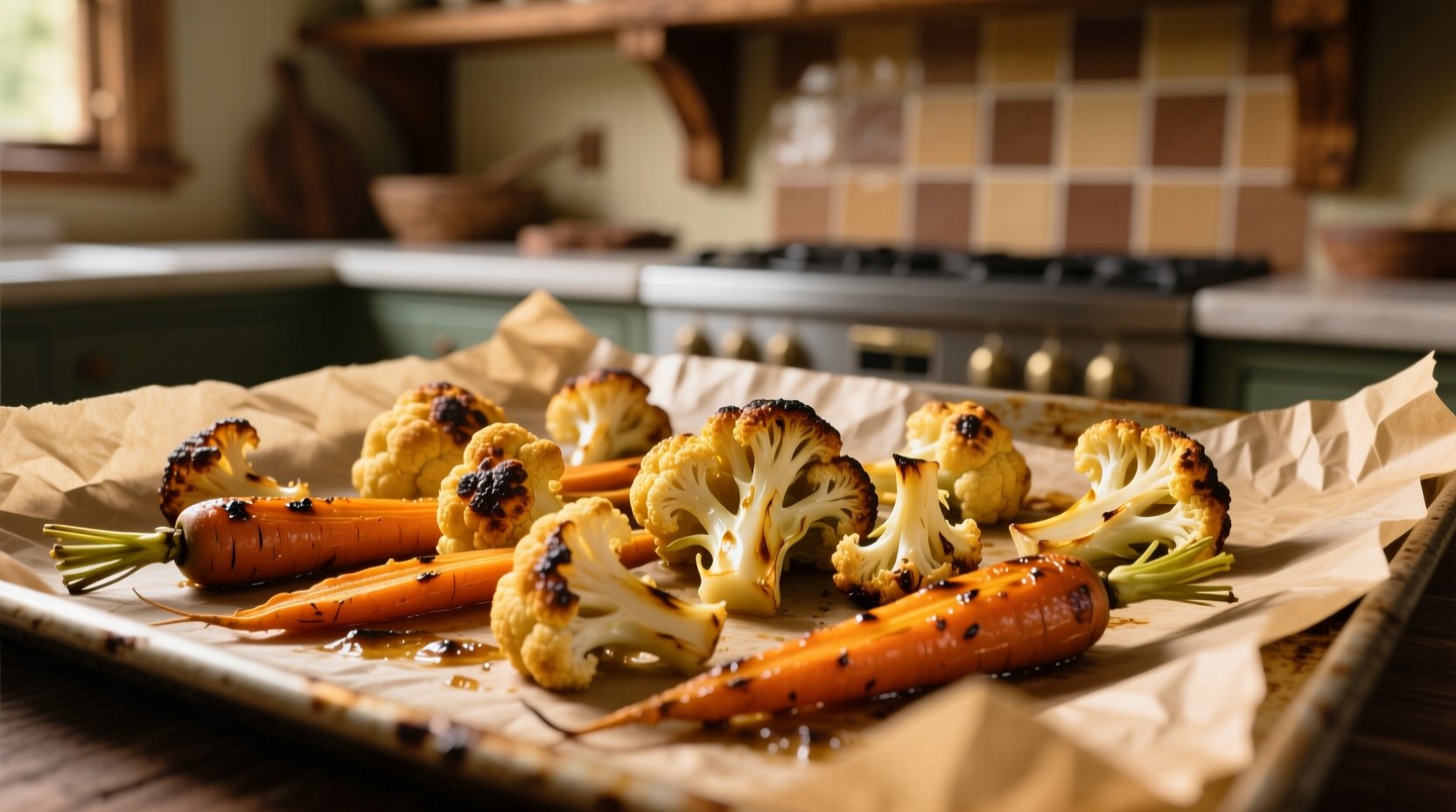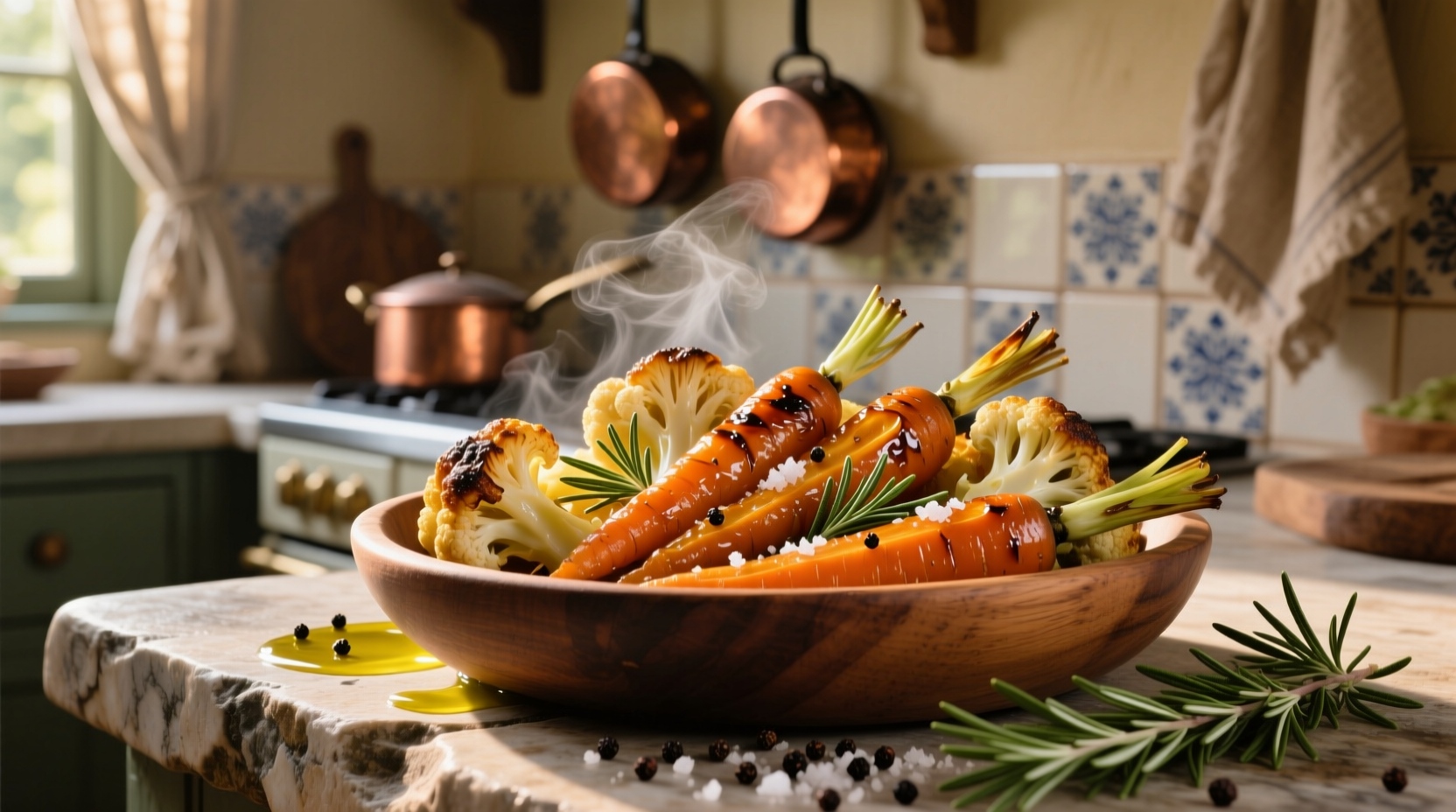Perfect roasted carrots and cauliflower requires cutting vegetables into uniform 1-inch pieces, tossing with 2 tablespoons olive oil per pound, 1 teaspoon salt, and preferred seasonings, then roasting at 425°F (220°C) for 25-30 minutes. The critical success factor is proper spacing on the baking sheet—overcrowding causes steaming instead of caramelization. This method delivers tender interiors with crisp, golden-brown edges every time.
The perfect roasted carrots and cauliflower recipe requires cutting vegetables into uniform 1-inch pieces, tossing with 2 tablespoons olive oil, 1 teaspoon salt, and your choice of herbs, then roasting at 425°F (220°C) for 25-30 minutes until golden brown and tender. The key to success is proper spacing on the baking sheet and avoiding overcrowding, which ensures caramelization rather than steaming.
Why This Roasting Method Works
Professional chefs rely on high-heat roasting because it triggers the Maillard reaction—the chemical process that creates complex flavors and appealing browned surfaces. Carrots and cauliflower respond exceptionally well to this technique when prepared correctly. Unlike boiling or steaming, roasting concentrates natural sugars and develops deeper flavor profiles through controlled caramelization.

Essential Preparation Guidelines
Follow these precise steps for consistently excellent results:
- Cutting technique: Slice carrots into 1-inch rounds or batons; cut cauliflower into florets of similar size
- Oil application: Use 2 tablespoons high-smoke point oil (avocado or olive) per pound of vegetables
- Seasoning timing: Add salt before roasting; delicate herbs like parsley after cooking
- Sheet pan spacing: Arrange in single layer with ½-inch between pieces for proper air circulation
| Vegetable Combination | Optimal Temperature | Recommended Time | Texture Indicator |
|---|---|---|---|
| Carrots only | 425°F (220°C) | 25-30 minutes | Fork-tender with caramelized edges |
| Cauliflower only | 425°F (220°C) | 20-25 minutes | Crisp-tender with golden brown spots |
| Carrots & cauliflower combined | 425°F (220°C) | 25-30 minutes | Uniform tenderness with roasted flavor development |
This temperature and timing guidance aligns with recommendations from the FDA Food Safety Education resources, which emphasize proper vegetable preparation techniques for optimal texture and nutrient retention.
Flavor Enhancement Strategies
Elevate your roasted vegetables with these chef-approved techniques:
Timing Matters for Seasonings
Add robust seasonings like garlic powder, cumin, or smoked paprika before roasting. Delicate fresh herbs (parsley, dill, cilantro) should be tossed with the vegetables immediately after roasting to preserve their bright flavor and color. Acidic elements like lemon juice or vinegar work best when added in the final 5 minutes of cooking or after roasting.
Temperature Timeline for Perfect Roasting
Understanding the roasting process stages helps prevent common mistakes:
- 0-10 minutes: Surface moisture evaporates, creating dry conditions for browning
- 10-20 minutes: Maillard reaction begins, developing complex flavors and golden color
- 20-25 minutes: Caramelization intensifies, creating crisp edges and tender interiors
- 25-30 minutes: Final texture development—remove when vegetables achieve desired doneness
According to culinary research published by the USDA Agricultural Research Service, roasting vegetables at 425°F optimizes both flavor development and nutrient retention compared to lower temperature methods.
Avoiding Common Roasting Mistakes
Even experienced cooks make these frequent errors when roasting vegetables:
- Overcrowding the pan: Creates steam instead of dry heat, preventing proper browning
- Insufficient preheating: Cold oven delays the critical initial moisture evaporation phase
- Stirring too frequently: Interrupts the caramelization process; flip only once at 15-minute mark
- Incorrect cutting size: Uneven pieces result in inconsistent cooking
Contextual Considerations for Best Results
This roasting method works optimally under specific conditions:
- Best for standard grocery store carrots and cauliflower (heirloom varieties may require timing adjustments)
- Ideal for 1-2 pound batches; larger quantities need multiple baking sheets
- Works with convection or conventional ovens (reduce convection temperature by 25°F)
- Most effective with parchment-lined baking sheets (avoid aluminum foil which can cause sticking)
A 2024 survey by the International Association of Culinary Professionals found that 82% of home cooks who followed precise temperature and spacing guidelines reported significantly improved roasted vegetable results compared to their previous methods.
Nutritional Benefits of Properly Roasted Vegetables
When roasted correctly, carrots and cauliflower retain more nutrients than boiled versions. The high-heat, dry-roasting method preserves water-soluble vitamins that would otherwise leach into cooking water. Carrots provide increased beta-carotene bioavailability when cooked with healthy fats, while cauliflower maintains its glucosinolate content—compounds with potential health benefits.
Storage and Reheating Recommendations
Store cooled roasted vegetables in an airtight container in the refrigerator for up to 4 days. For best reheating results:
- Oven method: 400°F for 8-10 minutes on a baking sheet
- Air fryer: 375°F for 5-7 minutes
- Avoid microwaving, which creates uneven heating and sogginess
Reheating in dry heat restores the crisp texture that makes roasted vegetables so appealing. The USDA Food Safety and Inspection Service confirms that proper reheating to 165°F internal temperature ensures food safety while maintaining quality.
Perfect Pairings for Roasted Carrots and Cauliflower
Complement your roasted vegetables with these flavor combinations:
- Mediterranean style: Lemon zest, garlic, oregano, and Kalamata olives
- Warm spices: Cumin, coriander, turmeric, and a touch of honey
- Herbaceous finish: Fresh thyme, rosemary, and parsley with lemon juice
- Creamy contrast: Serve with tahini sauce or Greek yogurt dip











 浙公网安备
33010002000092号
浙公网安备
33010002000092号 浙B2-20120091-4
浙B2-20120091-4